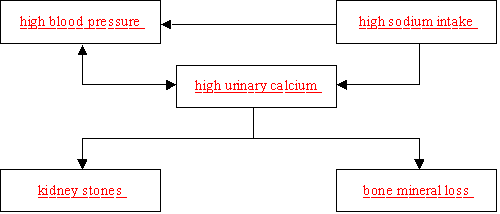Osteoporosis
The link between salt intake and osteoporosis is based on the so-called 'four cornerstones' hypothesis. The pathophysiological mechanisms in this hypothesis are not fully understood, but epidemiological evidence has been accumulating which supports the links (Cappuccio et al., 2000). In particular, cross-sectional studies have shown a significant negative association between blood pressure and bone mineral density. Inverse associations have also been reported between bone mineral density and stroke incidence, and between bone mineral density and cardiovascular mortality. The hypothesis linking these features is shown in Figure 2. A high sodium intake has the effect of increasing both blood pressure and urinary calcium output (Teucher and Fairweather-Tait, 2003). High urinary calcium excretion is a risk factor for urinary crystal formation (urolithiasis) and kidney stone disease in the general population. Hypercalciuria and associated hyperparathyroidism can also lead to reduced bone mineral content later in life, especially in hypertensive people, and osteoporosis with or without osteopenia.
Figure 1.2 The four cornerstones hypothesis (Source: Cappuccio, et al, 2000)
